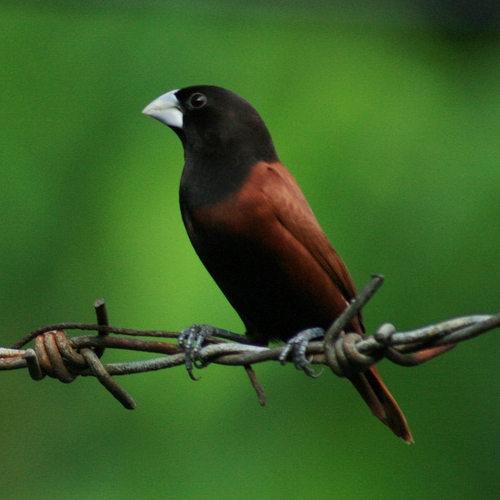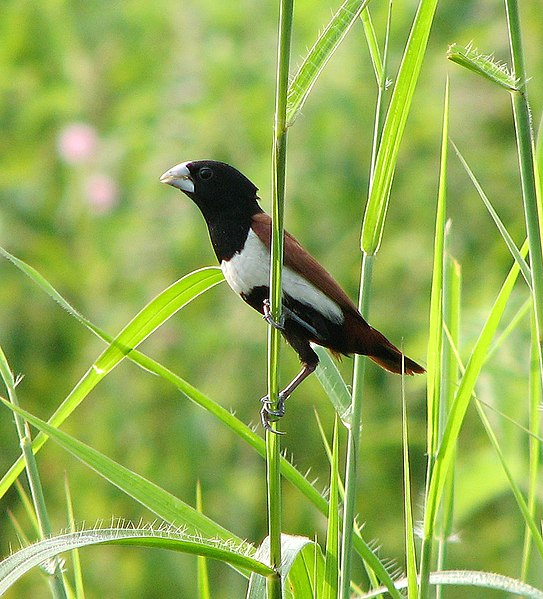 Also known as Tri-Colored and Black-Headed Nuns or Mannikins (Lonchura Malacca and L. atricapilla), these pert little birds make excellent pets for both beginning and advanced finch keepers. While neither sports the flashy colors of certain related species, contrasting black, chestnut and white plumage renders them quite striking.
Also known as Tri-Colored and Black-Headed Nuns or Mannikins (Lonchura Malacca and L. atricapilla), these pert little birds make excellent pets for both beginning and advanced finch keepers. While neither sports the flashy colors of certain related species, contrasting black, chestnut and white plumage renders them quite striking.
Natural History
The 5-inch-long Tri-Colored Munia is found in southern India and Sri Lanka. It is most common in and near swamps, flooded meadows, riversides, rice fields and other moist, open habitats.
The Black-Headed Munia was long considered to be a subspecies of the Tri-Colored, but has now been designated as a distinct species. However, captives interbreed readily, and will also pair up with related finches. Its natural range, which lies north and east-southeast of the Tri-Color’s, extends from northern India through southern China, Thailand and Vietnam. It tops out at 4.5 inches in length.
Both species rely upon grass seeds as their primary food, and may form large flocks outside of the breeding season.
Captive Care: Housing
 Due to their diminutive size, Munias are usually kept in quite small cages. While most will adjust to such accommodations, they will be much more content and active (and more interesting to observe!) if provided with a large flight cage.
Due to their diminutive size, Munias are usually kept in quite small cages. While most will adjust to such accommodations, they will be much more content and active (and more interesting to observe!) if provided with a large flight cage.
Outdoor aviaries are ideal for small groups. If not crowded, they will get along well with other similarly-sized finches, but aggression can occur during the breeding season.
Diet
A high quality finch seed mix containing dehydrated fruit and vegetables (they do not take much fresh fruit, but seem to benefit from dried bits included in commercial diets) should form the basis of the diet.
Small amounts of chopped kale, romaine and other greens, as well as fresh sprouts, should be offered several times weekly. Soaked seed are beneficial to pairs rearing chicks.
Although most accounts claim that Tri-Colored and Black-Headed Munias will not eat insects, those under my care have taken waxworms, mealworms, wingless houseflies and small crickets. Perhaps food preferences vary among different populations, and this is reflected by captive bred descendants. In any case, I suggest offering insects, especially during the breeding season.
grit and cuttlebone should always be available.
Breeding
Breeding is most likely to occur when a pair has plenty of room.
 In the wild, both species construct a covered, oval nest of dried grasses and moss, usually located 6-8 feet above-ground. Nesting baskets may be accepted by captives.
In the wild, both species construct a covered, oval nest of dried grasses and moss, usually located 6-8 feet above-ground. Nesting baskets may be accepted by captives.
Both parents incubate their 4-5 eggs for 12-14 days. The young fledge when they are approximately 3-4 weeks old.
Special Considerations
In common with other savanna-adapted finches, Black-Headed and Tri-Colored Munias have very long, curved nails that assist them in clinging to swaying grass stems while feeding. Their nails grow quickly and may become entangled in cage mesh or wire if not trimmed regularly. Be sure to seek assistance from an experienced bird keeper or veterinarian if you are not familiar with nail-clipping.
Further Reading
Black-Headed Munia videos and sound recordings
Finch Facts: an overview
Video: wild Tri-Colored Munias
Black Headed Munia image referenced from wikipedia and originally posted by Heini Wang and Snowmanradio
Tri-color Munia image referenced from wikipedia and originally posted by Krayker
Munia Nest image referenced from wikipedia and originally posted by Kguirnela
 That Bird Blog – Bird Care and History for Pet Birds
That Bird Blog – Bird Care and History for Pet Birds



